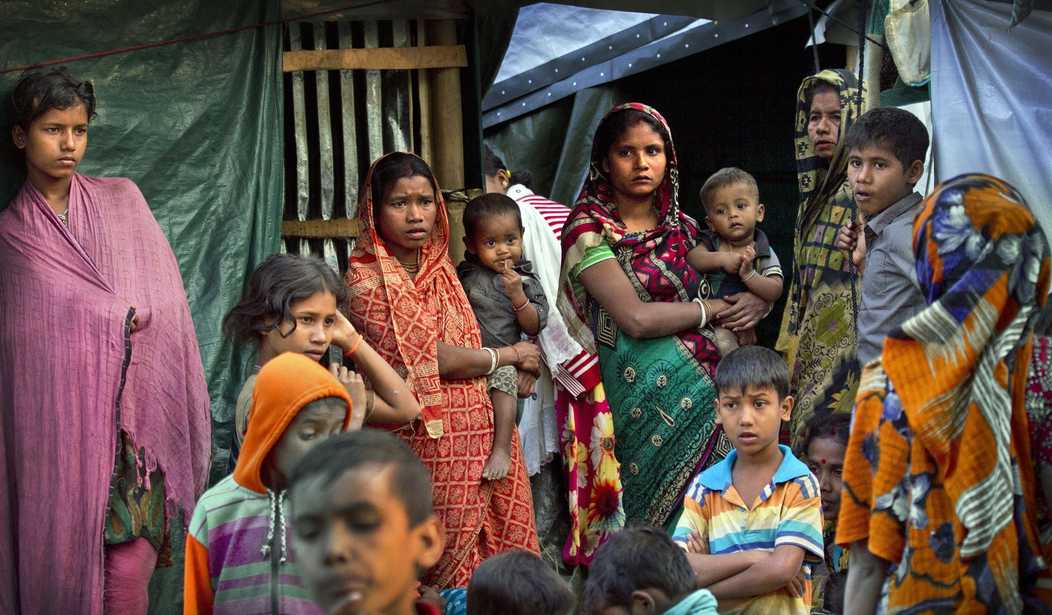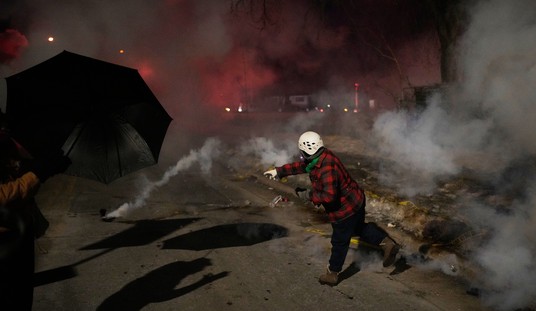Following Bangladesh Prime Minister Sheikh Hasina's removal from power and her fleeing the country on August 5—a situation resulting from mass student protests—Hindus have experienced deadly attacks by Islamists.
Social media is filled with reports of Hindus being raped or murdered, their properties and temples attacked, burnt down, and looted.
Based on statements by Bangladeshi Hindu individuals and organizations, the news website OpIndia confirmed these reports.
"Hindus are subjected to rapes, murders, lynchings, and institutionalized abuse including hospitals not treating Hindu victims. Their temples have been burnt and they've been abused with 'kafir' (infidel) slurs."
In another report, Hindu women narrated their ordeal and confirmed the rape of Hindu women in Bangladesh. They said, "They tied her mouth and raped her, they wanted to slit her throat, we gave our ornaments to save her."
Hindus make up approximately 9 percent of Bangladesh's population and are the largest religious minority within the Muslim-majority nation.
An interim government was formed on August 8. The interim government also acknowledged that Hindus were being specifically targeted and attacked.
The country's Hindus have traditionally supported the ousted Awami League party because of its identity as a secular party, as opposed to opposition parties like the Jamaat-e-Islami, an Islamist party, or the Bangladesh Nationalist Party, which often allies with Jamaat.
The Bangladesh Hindu Buddhist Christian Unity Council and the Bangladesh Puja Udjapan Parishad presented data demonstrating that there have been at least 205 attacks on Hindus and other minorities in 52 districts since the fall of the Hasina-led government.
"Thousands of Hindu families have become destitute and many temples have been attacked and burned. Numerous women have faced assaults, and there have been murders in several places. Other minorities have also suffered during this period," according to data compiled by the two organizations.
They presented the data in an open letter to Muhammad Yunus, who was sworn in as the chief adviser of the interim government.
Nirmal Rosario, one of the three presidents of the unity council, said the situation was deteriorating. Rosario urged the interim government's chief to resolve the crisis by giving it top priority and putting an end to the violence.
"We seek protection because our lives are in a disastrous state. We are staying up at night, guarding our homes and temples. I have never seen anything like this in my life. We demand that the government restore communal harmony in the country."
This is not the first time Hindus in Bangladesh have been violently targeted. Hindus and other non-Muslim minorities have for decades suffered from the violence of Islamist groups, such as Jamaat-e-Islami, as well as political parties and broader Muslim society.
Pogroms have killed thousands of Bangladeshi minorities, particularly Hindus; millions more have become refugees in India. Hence, the Hindu population has decreased from 22% in the 1940s to approximately 9% today.
The land that’s now called Bangladesh, however, was majority Hindu before Islamic armies invaded the region in the 10th century. Author Chowdury G.R, who details the decades-long persecution against Hindus and non-Muslims in Bangladesh, notes:
"Bangladesh is an ancient land with a long history. Together with the present-day Indian state of West Bengal, ancient Indian scriptures refer to it as Banga desh (land). Banga, which the English called Bengal, covers the world's largest delta, that of the rivers of Ganga and Brahmaputra."
Sadly, Hinduism and other non-Muslim faiths of South Asia have been in a severe decline due to Islam's violent takeover. Since Islam invaded the Indian subcontinent in the 8th century, massacres against non-Muslims, forced conversions to Islam, rapes and desecrations of non-Muslim temples have become common occurrences. They have never ended.
In 1947, India was partitioned into the independent countries of the secular republic of India and the Islamic Republic of Pakistan. Bangladesh then became part of Pakistan.
Anti-Hindu pogroms in Bangladesh (then East Pakistan) took place in 1947, 1949, 1951, 1952, 1954, 1956 1564, and 1971. Chowdury explains :
Pakistan's military-bureaucratic rulers routinely used anti-Hindu riots and anti-India slogans to slow the growth of Bengali nationalism.
In 1964, at the height of the Bengali nationalist movement, Pakistan unleashed a reign of terror. Estimates of the number of Hindus murdered vary from 10,000 to several times that. In the wake of 1964's reign of terror alone, over 1.1 million refugees went to India.
Then came Pakistan's 1971 genocide targeting Hindu and other minorities in Bangladesh (then East Pakistan), affecting the lives, homes, and businesses of almost all Hindu families. According to the Hindu American Foundation,
On March 25, 1971, the Pakistan military began a 10-month campaign of genocide against the ethnic Bengali and Hindu religious communities in East Pakistan, a clear example of the facets of genocide as defined the United Nations Genocide Convention. This spurred the 10-month Bangladesh Liberation War and later the 13-day Indo-Pakistan war. Both ended on December 16, 1971 with the surrender of Pakistan.
In the eyes of the Pakistani military, Hindu, Bengali, and Indian identities were one and the same. Although Hindus were a special target of the Pakistan military, Bengali Muslim, Christian, Buddhist, and other religious groups were also significantly affected. By the end of the first month in March 1971, 1.5 million Bengalis were displaced. By November 1971, 10 million Bengalis, the majority of whom were Hindu, had fled to India.
Although precise figures are difficult to obtain, approximately 3 million people were killed and at least 200,000 women were raped.
During the genocide, writes Chowdury G.R.,
Bengali police and the Pakistani army frequently stopped men, stripped them naked to check whether they were circumcised or not, and asked them to recite from the Koran. Non-Muslim women were practically barred from wearing anything that would identify them as such, since their identification as anything but Muslim could mean instant death.
Chowdury explains that organized attacks on minorities and their temples, including churches, increased significantly in the last half of 1980s, with large-scale attacks in 1987, 1989, and 1990.
In 1989, over 400 temples were destroyed or damaged. This wave reached its height with the destruction or desecration of perhaps 80 percent of Bangladesh's Hindu-Buddhist temples and the devastation of thousands of Hindu homes and businesses between October 30 and November 1, 1990.
In February 1991, the Bangladeshi journal Parishad Barta listed thousands of temples, churches, homes, and businesses destroyed between October 30 and November 1, 1991. It also listed Christian churches, schools, hospitals, and homes attacked in January and February 1991 at the beginning of the Gulf War.
Bangladesh's minority population has declined drastically since the 1947 partition of India. Where have these people gone? All have headed to India… Estimates of the total number of Bangladeshi-origin Hindu, Buddhist, Christian, and tribals in India vary between 26 million and 38 million.
The Islamic jihad targeting Hindus has been so bloody and brutal that many researchers call it "the largest genocide in human history."
British Hindu human rights activist Dr. Melissa Kapoor says that Hindus have survived centuries-long persecution, but their survival has come at a very high cost.
"There has been some very good research done to understand the extent of the Hindu genocide by sadly a relatively small number but very dedicated individuals and people like Koenraad Elst, François Gautier, Stephen Knapp, an organization called Ishittva Dharma Sansthapan Foundation. They have been collating all of the evidence of different epochs of genocide throughout the last 1.000 years of Hindus and trying to come up like a total figure. And the consensus is it is certainly in the hundreds of millions and that's a conservative estimate.
"And of course on top of that you have hundreds of millions more Hindus who have been raped, who have been forced to flee, who have been tortured, who have been forced to convert to Abrahamic religions. And all this began with the Islamic invaders roughly near the 11th century.
"Their main mode of destruction was genocide. It was physical destruction, it was killing, it was raping, it was destroying temples. It was burning down libraries. So a lot of this destruction actually you can see today still in part with your own eyes.
When people are researching these eras of Hindu history, you only have to look at the records of the perpetrators to get the figures to understand the extent of all of this genocide and destruction. Many of the Islamic Invaders, their own secretaries, and Muslim chroniclers themselves are the sources of these numbers.
For example, the Islamic conqueror Timur boasts in the records of killing 100,000 Hindus in a single day or the Bahmani Sultans who make the record that they have a target of killing 100,000 Hindus a year spanning a roughly 200-year period.
And there are so many of these examples. The Hindu Kush mountains which span Afghanistan and Pakistan… They're called 'Hindu Kush' because 'kush' means 'slaughter'. It's the mountains of 'the Hindu Slaughter' and there are descriptions of there being such a rapid extermination of Hindus there that literally Hindu blood would flow down the mountains so the extent of the genocide in these periods caused by these Islamic invaders is completely undeniable and it's very, very massive…
Kapool notes that the Hindu genocide is ongoing in India's neighboring Islamic countries, such as Pakistan and Bangladesh. "In those countries, Hindus have faced a terrible existence and very harrowing accounts," says Kapool. “In Bangladesh 22 percent of the population were Hindus in 1951 but today that figure's more like eight percent."
"During the 1971 Bangladesh genocide that was committed by Pakistan, we know the figure of three million were killed. What people do not realize is that nearly 85 percent of those three million killed were Hindus even though Hindus only accounted for 19 percent of the population in Bangladesh at that time.”
Kapool argues that the Islamist genocide of Hindus continues in India. As an example, she refers to the 2002 attack against Hindu pilgrims. On the morning of February 27, 2002, a train in Godhra carrying Hindu pilgrims returning from Ayodhya was burnt by Islamists. As a result of the fire, 59 Hindus, including women and children, were burned to death. Dr Kapool adds:
Hardly a day goes by where you don't hear about a village in Bangladesh of Hindus being burnt down, or of a young Hindu girl in Pakistan being abducted and forced to marry a man three times her age of a different religion or a Hindu in India being shot and stabbed - all for being Hindus.
Hindus in Bangladesh are facing yet another threat of genocide at the hands of Islamists, whom the Bangladeshi military appears to be enabling. Hopefully, this time, the international community will not abandon them and help protect Hindu lives in Bangladesh.










Join the conversation as a VIP Member